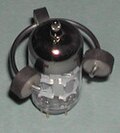Microphonics: Difference between revisions
CSV import Tags: mobile edit mobile web edit |
CSV import |
||
| Line 26: | Line 26: | ||
{{Electronics-stub}} | {{Electronics-stub}} | ||
== Microphonics gallery == | |||
<gallery> | |||
File:Ultraii2.jpg|Ultra II | |||
File:Valve hammer.jpg|Valve Hammer | |||
</gallery> | |||
Latest revision as of 05:27, 3 March 2025
Microphonics or microphony refers to the phenomenon where certain components in electronic devices transform mechanical vibrations into an undesired electrical signal (noise). This issue is most prevalent in vacuum tubes, capacitors, and cables, especially in high-gain audio amplifiers, radio transmitters, and sensitive measuring equipment. The term originates from the early days of radio and phonograph technology, where microphonic effects were first observed.
Causes and Effects[edit]
Microphonics is caused by mechanical vibrations that induce an electrical signal in a component. In vacuum tubes, for example, these vibrations can modulate the distance between the anode and cathode or between other elements within the tube, altering the flow of electrons and thus the current. This modulation translates into noise that can be amplified by the device, leading to feedback, hum, or other unwanted sounds. In capacitors, mechanical stress can change the capacitance, while in cables, it can modulate the resistance or induce piezoelectric effects.
The impact of microphonics varies depending on the application. In audio equipment, it can degrade sound quality by introducing noise and feedback. In radio transmitters, it can cause frequency modulation of the signal, leading to interference. In sensitive measuring instruments, it can introduce significant errors in the measurements.
Mitigation[edit]
To mitigate microphonics, manufacturers and users employ various strategies. These include:
- Using components that are less susceptible to microphonics, such as solid-state devices instead of vacuum tubes.
- Mechanical damping of components to reduce their vibration.
- Careful physical layout of the device to minimize the impact of vibrations.
- Using low-noise cables and connectors.
- Encasing sensitive components in epoxy or other damping materials.
Examples[edit]
One classic example of microphonics is the feedback heard when a microphone is too close to a speaker. In this case, the sound from the speaker causes the microphone diaphragm to vibrate, which is then amplified and sent back to the speaker, creating a feedback loop. In vacuum tube amplifiers, tapping on the chassis can produce a ringing or buzzing sound through the speakers, indicating microphonic tubes.
Conclusion[edit]
Microphonics presents a challenge in the design and use of electronic devices, particularly in audio and radio applications. Understanding the causes and implementing effective mitigation strategies is essential for minimizing its impact and ensuring the quality and reliability of electronic equipment.
Microphonics gallery[edit]
-
Ultra II
-
Valve Hammer


